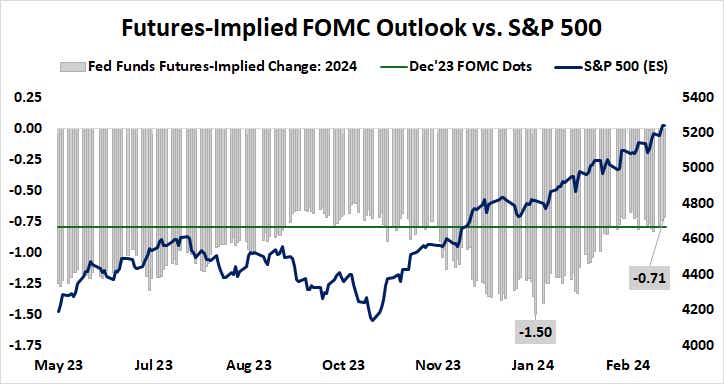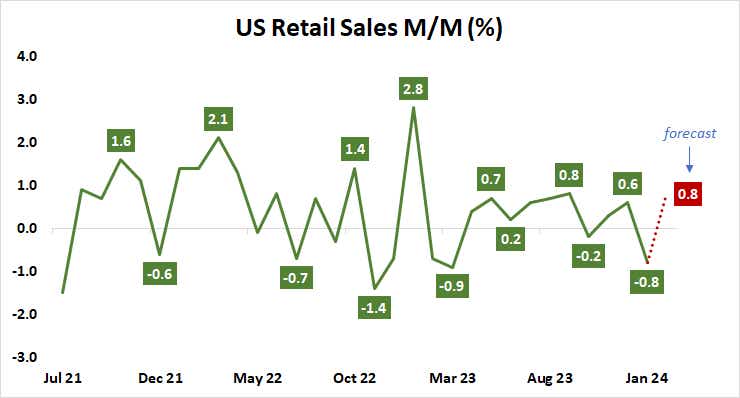U.S. Retail Sales Preview: Stocks at Risk if Data Cools Fed Rate Cut Bets

U.S. Retail Sales Preview: Stocks at Risk if Data Cools Fed Rate Cut Bets
By:Ilya Spivak
Stock markets may wobble if strong U.S. retail sales data pushes back Fed rate-cut expectations further
- Stock markets shrugged off hotter-than-expected U.S. CPI inflation.
- The focus is now on retail sales data, where strong results are eyed.
- Shifting to 61bps or less in 2024 Fed rate cuts may hurt Wall Street.
Financial markets settled on a curious response to February’s hotter-than-expected U.S. inflation data.
Headline price growth registered at 3.2% year-on-year, marking an unexpected rise from January’s 3.1%. The core rate excluding volatile food and energy prices ticked lower to 3.8% from 3.9% previously, but overshot bets on a steeper slide to 3.7%.
Bond yields dutifully rose as the priced-in outlook for Federal Reserve monetary policy shifted to a less-dovish setting, pushing Treasury bonds lower. That, in turn, weighed on gold prices and Japanese yen. Fed funds futures now see 71 basis points (bps) in cuts this year, the lowest in two weeks.
Price action gets murkier from there. The U.S. dollar broadly idled, oscillating in a choppy intraday range before settling with meager 0.08% rise against an average of its top counterparts. Stock markets offered the most head-scratching interpretation however: the bellwether S&P 500 rose 1.06% while the Nasdaq added 1.43%.
Do stocks still care about Fed rate cuts?
Wall Street cheered building rate-cut speculation in the closing months of 2023.
Stocks roared higher as the U.S. central bank signaled that its hiking cycle was likely at its peak and easing would arrive before long. Between late October and the start of the new year, 60bps turned into 150bps in expected rate cuts.

As 2024 got underway, that dovish bias stacked up favorably against the Fed’s own December forecast of 80 bps. If traders had it right, mounting evidence would push the central bank would have to acquiesce to cheaper money. Not surprisingly, stocks stayed aloft.
They have been resilient even as chipper economic data flow deflated market rate cut bets. Presumably, this reflected the view that any amount of easing that was greater than or equal to the Fed’s 80 bps baseline was supportive of risk-taking if the economy didn’t show signs of stress.
U.S. retail sales report in focus
Now, with 71bps in the forecast, the key question is whether shares can continue to march higher even if credit costs move to a more restrictive setting than Fed Chair Jerome Powell and company envisioned. At 61 bps, the outlook will have shifted to the likelihood of two cuts versus three. Next, the spotlight turns to February’s retail sales report.
Analysts expect a monthly rise of 0.8% in receipts. That would mark a welcome pickup from January, when they suffered the largest drawdown in 10 months. Perhaps most worryingly, the year-on-year growth rate fell to just 0.6%, the lowest since slump in the second quarter of 2020 amid the onset of the COVID-19 pandemic.
Leading purchasing managers index (PMI) data signaled that the consumer goods space outperformed among the seven major sectors of U.S. economic activity last month, while consumer services expanded at the fastest pace since August 2023. This might set the stage for brisk results that push down Fed rate cut expectations further.

Ilya Spivak, tastylive head of global macro, has 15 years of experience in trading strategy, and he specializes in identifying thematic moves in currencies, commodities, interest rates and equities. He hosts Macro Money and co-hosts Overtime, Monday-Thursday. @Ilyaspivak
For live daily programming, market news and commentary, visit tastylive or the YouTube channels tastylive (for options traders), and tastyliveTrending for stocks, futures, forex & macro.
Trade with a better broker, open a tastytrade account today. tastylive, Inc. and tastytrade, Inc. are separate but affiliated companies.
Options involve risk and are not suitable for all investors. Please read Characteristics and Risks of Standardized Options before deciding to invest in options.
tastylive content is created, produced, and provided solely by tastylive, Inc. (“tastylive”) and is for informational and educational purposes only. It is not, nor is it intended to be, trading or investment advice or a recommendation that any security, futures contract, digital asset, other product, transaction, or investment strategy is suitable for any person. Trading securities, futures products, and digital assets involve risk and may result in a loss greater than the original amount invested. tastylive, through its content, financial programming or otherwise, does not provide investment or financial advice or make investment recommendations. Investment information provided may not be appropriate for all investors and is provided without respect to individual investor financial sophistication, financial situation, investing time horizon or risk tolerance. tastylive is not in the business of transacting securities trades, nor does it direct client commodity accounts or give commodity trading advice tailored to any particular client’s situation or investment objectives. Supporting documentation for any claims (including claims made on behalf of options programs), comparisons, statistics, or other technical data, if applicable, will be supplied upon request. tastylive is not a licensed financial adviser, registered investment adviser, or a registered broker-dealer. Options, futures, and futures options are not suitable for all investors. Prior to trading securities, options, futures, or futures options, please read the applicable risk disclosures, including, but not limited to, the Characteristics and Risks of Standardized Options Disclosure and the Futures and Exchange-Traded Options Risk Disclosure found on tastytrade.com/disclosures.
tastytrade, Inc. ("tastytrade”) is a registered broker-dealer and member of FINRA, NFA, and SIPC. tastytrade was previously known as tastyworks, Inc. (“tastyworks”). tastytrade offers self-directed brokerage accounts to its customers. tastytrade does not give financial or trading advice, nor does it make investment recommendations. You alone are responsible for making your investment and trading decisions and for evaluating the merits and risks associated with the use of tastytrade’s systems, services or products. tastytrade is a wholly-owned subsidiary of tastylive, Inc.
tastytrade has entered into a Marketing Agreement with tastylive (“Marketing Agent”) whereby tastytrade pays compensation to Marketing Agent to recommend tastytrade’s brokerage services. The existence of this Marketing Agreement should not be deemed as an endorsement or recommendation of Marketing Agent by tastytrade. tastytrade and Marketing Agent are separate entities with their own products and services. tastylive is the parent company of tastytrade.
tastycrypto is provided solely by tasty Software Solutions, LLC. tasty Software Solutions, LLC is a separate but affiliate company of tastylive, Inc. Neither tastylive nor any of its affiliates are responsible for the products or services provided by tasty Software Solutions, LLC. Cryptocurrency trading is not suitable for all investors due to the number of risks involved. The value of any cryptocurrency, including digital assets pegged to fiat currency, commodities, or any other asset, may go to zero.
© copyright 2013 - 2024 tastylive, Inc. All Rights Reserved. Applicable portions of the Terms of Use on tastylive.com apply. Reproduction, adaptation, distribution, public display, exhibition for profit, or storage in any electronic storage media in whole or in part is prohibited under penalty of law, provided that you may download tastylive’s podcasts as necessary to view for personal use. tastylive was previously known as tastytrade, Inc. tastylive is a trademark/servicemark owned by tastylive, Inc.